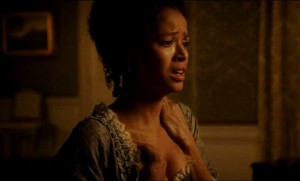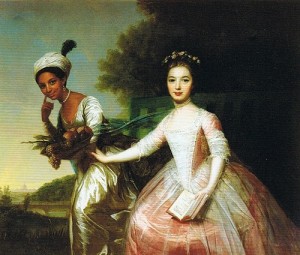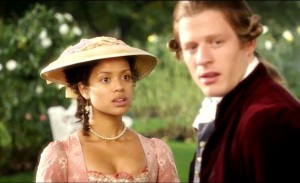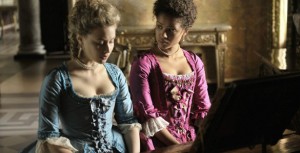Belle is a refreshing and important film to emerge from a long line of actual BBC helmed and or in this case, BBC-style ( I can’t believe it’s not BBC!) historical drama, romance, and classic novel-to-film treatments.While some said literary productions, mini-series and the like have begun to do more color-blind casting for historical dramas; the general atmosphere of said dreamy dramas is always…really white. I mean, yes, many characters in Dickens, Austen, Bronte and the like were white, but it’s 2014; about time to take some creative liberties. Give me a black Elizabeth Bennet already.
Belle is so far one of the few that gets us close to that, and in fact goes far beyond. It’s important and stands out because it’s lead is a woman of color, based on an actual person. That alone is striking and different. And yet with this film’s romance plotline’s ultimate predictability (that comes with the genre) and genuine earnestness, makes it no different than the sea of historical romances that have come before and will come after. It belongs. Which is the point, and a good thing. It’s not often you get a period film with characters of color as the lead, let alone one with an underlying romance granted to them. God forbid non-white people fall in love and are allowed to be vulnerable. It is a shame it’s so infrequent in Western film, particularly of this genre, because director Amma Asante and writer Misan Sagay with Belle shows how it can be effortlessly done. It’s not a stretch or a chore. It’s literally the same. To suggest otherwise or it impossible is ridiculous.

A heartbreaking scene where Dido ( Gugu Mbatha-Raw) melts down as she looks into the mirror. The film shows Dido’s struggle amongst the microagressions of the period despite her genteel upbringing.
HISTORY LESSON:
The film with its “and the kitchen-sink” all-star cast of British actors follows a dramatized life of the real 18th Century lady of color, Dido Elizabeth Belle (portrayed beautifully by Gugu Mbatha-Raw). Dido, illegitimate daughter of Admiral Sir John Lindsay (portrayed in a more or less moving cameo by Matthew Goode) and a black woman named Maria Belle, grew up as a free gentlewoman in the house of her great-uncle, William Murray, 1st Earl of Mansfield (Tom Wilkinson) after her mother dies. She lived there alongside her white cousin, Elizabeth Mary Murray (Sarah Gadon) whilst her great-uncle, who happened to be Lord Chief Justice, had to tend to large, controversial and racially based cases, Somerset v Stewart and the Zong massacre. His verdicts on both cases marked steps towards abolishing slavery in Britain, with his verdict for the former case ruling that slavery had never been established by statute in England and was not supported by common law. (Not to say that cleansed Britain of its horrific colonialism and treatment of peoples in India, Africa, China, and Australia among other places for the next 200 years to follow).
The film chose to follow the Zong case, filling in the gaps of what we know about Dido’s life as both a lady and as an heiress after the death of her father abroad. It elaborates greatly but shows how Dido is controlled by the strict racially based social constructs that even her family, who loves her, must more or less adhere to. She is not a servant; but she is not allowed to dine with the family when guests are over, rather is deemed Elizabeth’s lady companion later in the parlor. She is technically wealthy, especially after her father’s passing, but her skin denies her the perceived eligibility that her cousin has amongst the upper class. It’s all surprisingly very Austen. And the sensitivity shown in how it affects Belle; what she pays attention to (the paintings in her Great-Uncle’s gallery, sign paintings, etc of white people and black servants, thus her hesitation and anxiety to being painted alongside Elizabeth) is also well done.
Whilst a bubbling attraction occurs between young Dido and abolitionist preacher and aspiring lawyer John Davinier ( Sam Reid, in a revisionist version of her real life eventual husband) from the local country parish, you see a gradual thawing of her family and her eventual integration and introduction as a lady alongside her cousin. The dealings of the icy social constructs of the time, both as a woman and a being of mixed race are on full spotlight as Dido deals with her and particularly Elizabeth’s coming out. These are perhaps some of the best moments of the film as they bring out rather layered emotional content. It’s these shades of grey views of racism displayed during this portion of the film that are the most effective. It mirrors real life and institutionalized racism still is in place today, even in kind liberal people.
Whilst in real life her white cousin Elizabeth was also, I believe, an heiress, and wealthy, in the film they are painted as more or less inverses of each other; Dido’s father loved her, and following his death, she is wealthy, but has no position and her heritage impedes her. Elizabeth’s father is painted as negligent and whilst visually the perfect English Rose, she is given no dowry so while she has a title, she was not wealthy and or have property and thus not very desirable to upper class young men. It is then Dido who ultimately gets engaged before her cousin. Despite this; the relationship between the two girls is never truly sour (it’s believed they were rather affectionate in real life if going by the painting of the two women) and this alone is a breath of fresh air compared to what it could have been had it been handled less gently by a more “Hollywood” hand. Their relationship is loving, like sisters. And that is amazing to see on film for any movie with more than one female character regardless of the context.

The famous portrait of Dido and Elizabeth, which whilst being painted in the film stirs Dido’s concern and anxiety over being placed as “lower” than Elizabeth in the picture as most black or mixed race peoples are usually depicted, which ultimately does not occur. Elizabeth’s hand on her cousin’s waist denotes affection.
This friction in terms of eligibility between the two girls and their personal pitfalls (having what the other needs more or less) is emphasized during their courting by the snobby and power hungry sons of Lord Ashford; James (Tom Felton) and Oliver (James Norton). This part of the film is most interesting as it explores further that grey area of racism mixed with a great showcase of the etiquette, class and gender politics of that time. Love generally has little to do with marriage. Furthermore the Ashford’s are racist and classist so it is interesting when Oliver, the more handsome but unfortunately poor second son (he effectively mirrors movie Elizabeth in his circumstances) seemingly falls for Dido, it is in a way rather sweet. His boyish interest and proposal appears earnest, but he is also still racist. He loves her, but he also “forgives” her heritage and calls her exotic. This treatment of race is very, very effective as the microaggressions that even Oliver spouts prick very sharply. Few films pay attention to that kind of underlying racism. Tom Felton’s James is more outright racist, or rather the face of what we’ve come to expect racism to look like as opposed to Oliver’s more subtle kind. While first interested in Elizabeth; upon learning she is poor, James is no longer invested and from then on is a rather cartoonish foil disapproving of his younger brother’s interest in Dido culminating in him harassing and assaulting her (what he does exactly is a bit ambiguous). As you can expect; none of this goes well.
The performances in the film are sensitive and well balanced. Nothing is too overblown and for the most part entirely organic, with everyone deserving high praise. The dialogue is a bit on the melodramatic side of things, particularly John Davinier, but according to genre that’s not very surprising. Tom Felton’s James is a bit much, but the film showcases a wide spectrum of types of racism and someone had to be the more designated “racist villain” of the film. While well shot, Belle is not particularly stylized in its filming, it is again sensitive, but relatively unfussy. The costumes and sets are pretty, with some great use of color, particularly with Dido and Elizabeth’s gowns.
One big quibble, and this is the horticulturist and dramaturg in me; the gardens and a scene of roses being arranged feature anachronistic long-stemmed hybrid tea roses which were not bred until the late 1800s. Most roses back then in gardens were once bloomers or china roses which are shrubby and have short nodding stems. While I realize it is minor, it took me out of the film for a split second, but I know for most viewers this wouldn’t be an issue. Additionally, the last third of the film is when the fiction really starts taking the reigns and the former formal prickliness and filigree cage feeling of the era is sort of ditched and more modern sensibilities and movie storytelling creep in. Dido becoming increasingly involved in the Zong case, stealing maps and sneaking out to meet with John at pubs to converse with fellow abolitionists (never noted to have ever happened in real life), as well as the script delving into discussions about marrying for love over position. Overall those parts become a bit much. It’s not terribly jarring but after a much more delicate first half or so with more subtleties, it was a bit less effective and the end, for me, with Dido sneaking into the court galley, proved slightly clunky (though moving nonetheless).
That third quarter ultimately does not hurt the film too much, as I still recommend it as it is indeed a beautiful, sensitive, and earnest film. It’s an important one. Its role in providing a film amongst the longstanding tradition of classic Hollywood biopics, but for a mixed race woman from history is so sorely needed that it must be noted. Add in that the script was written by a black woman, directed by a black woman, and stars a mixed race woman; it’s is nothing short of astounding (which, it shouldn’t be, as that should be commonplace). The Western film industry, given it’s terrible percentages concerning films with poc leads and directors, women leads and directors, and especially poc women lead films and directors behind it, needs to catch up. Other directors; writers, take note of Belle. Everyone else; go see it while you can. Now.
Film Review: Belle
MPAA Rated PG. Running time: 105 mins
Directed by Amma Asante; written by Misan Sagay , director of photography, Ben Smithard; edited by Victoria Boydell and Pia Di Ciaula ; music by Rachel Portman; production design by Simon Bowles; costumes by Anushia Nieradzik ; produced by Damian Jones; released by Fox Searchlight Pictures (in US).
WITH: Gugu Mbatha-Raw, Sam Reid, Tom Wilkinson, Sarah Gadon, Penelope Wilton ,Miranda Richardson, James Norton, Tom Felton, Alan Mckenna, Bethan-Mary James and Matthew Goode.
See you all real soon
Max Eber
max@sub-cultured.com
Twitter: @maxlikescomics













